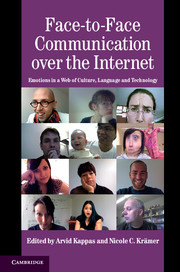Book contents
- Frontmatter
- Contents
- Preface
- Contributors
- Abbreviations
- Introduction
- Part 1 General aspects of visual cues in CMC
- Part 2 Video- and avatar-based communication
- 4 Nonverbal communication and cultural differences: issues for face-to-face communication over the internet
- 5 Video-linking emotions
- 6 Impact of social anxiety on the processing of emotional information in video-mediated interaction
- 7 Facing the future: emotion communication and the presence of others in the age of video-mediated communication
- 8 Virtual gestures: embodiment and nonverbal behavior in computer-mediated communication
- Part 3 Emotions and visual cues in HCI
- Index
- Studies in Emotion and Social Interaction
- References
8 - Virtual gestures: embodiment and nonverbal behavior in computer-mediated communication
Published online by Cambridge University Press: 05 June 2012
- Frontmatter
- Contents
- Preface
- Contributors
- Abbreviations
- Introduction
- Part 1 General aspects of visual cues in CMC
- Part 2 Video- and avatar-based communication
- 4 Nonverbal communication and cultural differences: issues for face-to-face communication over the internet
- 5 Video-linking emotions
- 6 Impact of social anxiety on the processing of emotional information in video-mediated interaction
- 7 Facing the future: emotion communication and the presence of others in the age of video-mediated communication
- 8 Virtual gestures: embodiment and nonverbal behavior in computer-mediated communication
- Part 3 Emotions and visual cues in HCI
- Index
- Studies in Emotion and Social Interaction
- References
Summary
Overview:Starting from an overview of the role of nonverbal channels in computer-mediated communication (CMC), a functional model of nonverbal behavior as a possible framework for future research is introduced. Based on this, several technologies and systems for avatar-based interaction are presented, and their impact on psychological aspects of the communication is discussed. The focus of the chapter lies on the discussion of methodological preconditions for the systematic analysis of avatar-based communication. An avatar-based communication platform is introduced that allows for real-time transmission of gaze, head movements, and gestures in net communication. Different research paradigms are discussed that might lead to a deeper understanding of the function of nonverbal cues in CMC.
Introduction
As we know from psychological research and also from our everyday experience, nonverbal behavior (NVB), such as facial expressions, gaze, gestures, postures, and body movements, has a strong impact on the process and the results of our communicative efforts. They help to structure the course of verbal exchange, they complement our speech activity, they determine our social impressions, and they affect the emotional climate of our conversations. In this sense we may consider our body as a natural communication tool that, in contrast to speech, is rarely used consciously and does not refer to an explicit semantic code. As Edward Sapir (1949 [1928]) pointed out, “We respond to gestures with an extreme alertness and, one might almost say, in accordance with an elaborate and secret code that is written nowhere, known to none, and understood by all” (p. 556).
- Type
- Chapter
- Information
- Face-to-Face Communication over the InternetEmotions in a Web of Culture, Language, and Technology, pp. 176 - 210Publisher: Cambridge University PressPrint publication year: 2011
References
- 13
- Cited by

